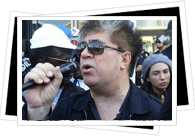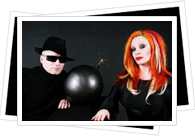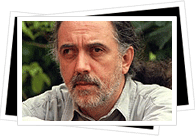La Movida in Madrid
They say if you can remember it, you didn't live through it.
Whether you lived through this explosive counter culture movement or not, here's an attempt to sum up the ever-more legendary period in recent Madrid history dubbed "La Movida Madrileña."
The Background
Madrid, November 19, 1975. Dictator Francisco Franco dies and, with him, 36 years of repression and censorship. The transition to democracy begins. King Juan Carlos I helps facilitate a smooth transition by quickly naming Adolfo Suárez Prime Minister.
1977: Spain votes democratically for the first time in over 40 years.
1978: a new constitution, in vigor to this day, is signed.
1979: Enrique Tierno Galván is voted mayor of Madrid.
1981: General Tejero, a Francoist, bursts into the Madrid's young parliament. The coup attempt is an utter failure.
1982: Spain votes the socialist PSOE party, headed by Felipe González, by a landslide. The country finds itself ruled by the first leftist government since the Second Republic in the 1930s.
The Spark
Madrid's newfound freedom of speech and expression prompted its citizens to do, well, anything and everything. Call it what you will - hedonistic, flamboyant, debaucherous, subversive, perverse, libertine - the overall sentiment was taboos don't exist and the harder you party, the better. Thus spawned La Movida, or "The Movement," a new way of drinking, drugging, rocking, dressing, cross-dressing, creating, loving, living.
The Setting What better setting for a cultural revolution than Madrid's most revolutionary plaza? The protagonists of La Movida dwelled around the area of Plaza Dos de Mayo in Malasaña, where madrileños first joined in rebellion against Napoleonic rule in 1808. Just off the plaza on calle la Palma 14, two artists - Juan Carrero and Enrique Naya - made their apartment into the Costus art studio, a meeting point for La Movida's protagonists. Among these, Alaska, Miguel Ordóñez, Fabio McNamara, Carlos Berlanga, Pedro Almodóvar and Blanca Sánchez stand out. When outside of Costus, the motley crew would frequent bars now legendary like El Penta (c/ Palma 4), La Vía Láctea (c/ Velarde 8) and El Sol (c/ Jardines 3).
What better setting for a cultural revolution than Madrid's most revolutionary plaza? The protagonists of La Movida dwelled around the area of Plaza Dos de Mayo in Malasaña, where madrileños first joined in rebellion against Napoleonic rule in 1808. Just off the plaza on calle la Palma 14, two artists - Juan Carrero and Enrique Naya - made their apartment into the Costus art studio, a meeting point for La Movida's protagonists. Among these, Alaska, Miguel Ordóñez, Fabio McNamara, Carlos Berlanga, Pedro Almodóvar and Blanca Sánchez stand out. When outside of Costus, the motley crew would frequent bars now legendary like El Penta (c/ Palma 4), La Vía Láctea (c/ Velarde 8) and El Sol (c/ Jardines 3).
The Influences
Boy George, David Bowie, Lou Reed, Brit Punk Rock, New Wave, Glam, Rocky Horry Picture Show...
The Mayor
It's not often a politician openly and avidly supports a counterculture movement. But then again, Enrique Tierno Galván was not your conventional mayor. Forced out of the Spanish university system in the 1960's for leading student protests against the dictatorship, Tierno Galván returned well-weathered from his tenure at Princeton to jump into transition-era politics. "The Old Professor," as he was affectionately called, believed that La Movida was extremely healthy for post-Franco society. What's more, he and socialist Prime Minister Felipe González recognized the import of selling a new, modern image of Spain to the outside world. The country had a lot of catching up to do after almost four decades of isolation and dictatorship: la Movida was both a manifestation of this progress and a marketing point to prove that change for the better was underway.
The Queen  Outside of Spain, Pedro Almodóvar is the most famous Movida veteran by far. But ask anyone here who the propelling force was and they'll tell you without hesitation: Alaska. Initially adored as the lead singer of punk/pop/new wave bands like Kaka de Luxe (1978), Alaska y los Pegamoides (1979) and Alaska y Dinarama (1983), she took a revolutionary turn as one of the hosts of "La Bola de Cristal" (The Crystal Ball), a children's TV show. La Bola de Cristal set out to treat children as adults, forming an entirely vanguard concept for its genre with "electroduendes" (freaky puppets donned electronic powers), "la pandilla basura" (the trash gang) and musical performances by contemporary rock bands. Alaska was the "Bruja Avería," a post-modern rocker witch and alternative role model for Spanish children of the eighties.
Outside of Spain, Pedro Almodóvar is the most famous Movida veteran by far. But ask anyone here who the propelling force was and they'll tell you without hesitation: Alaska. Initially adored as the lead singer of punk/pop/new wave bands like Kaka de Luxe (1978), Alaska y los Pegamoides (1979) and Alaska y Dinarama (1983), she took a revolutionary turn as one of the hosts of "La Bola de Cristal" (The Crystal Ball), a children's TV show. La Bola de Cristal set out to treat children as adults, forming an entirely vanguard concept for its genre with "electroduendes" (freaky puppets donned electronic powers), "la pandilla basura" (the trash gang) and musical performances by contemporary rock bands. Alaska was the "Bruja Avería," a post-modern rocker witch and alternative role model for Spanish children of the eighties.
The Music
If you want to get a taste of the era, plug in music by Mecano, Alaska y los Pegamoides, Radio Futura, Nacha Pop, Tino Casal, Siniestro Total, Loquillo y los Intocables, Alaska y Dinarama, Los Secretos, Los Elegantes and La Modé, to name a few.
The Films  Movies like "Arrebato" (1979) by Iván Zulueta , "Colegas" (1982) by Eloy de la Iglesia and "Ópera Prima" (1980) by Fernando Trueba prove there was much more to La Movida cinema than Pedro Almodóvar. Nevertheless, we can't ignore his mythical status as the figure of La Movida. Forget his Oscar-winning films like "All About My Mother" (1999) and "Talk to Her" (2002) -- you have to dig back into the crude eighties to truly understand the Movida aesthetic with "Pepi, Luci, Bom y otras chicas del montón" (1980), "¿Qué he hecho yo para merecer esto?" (1984) and "Mujeres al borde de un ataque de nervios" (1988).
Movies like "Arrebato" (1979) by Iván Zulueta , "Colegas" (1982) by Eloy de la Iglesia and "Ópera Prima" (1980) by Fernando Trueba prove there was much more to La Movida cinema than Pedro Almodóvar. Nevertheless, we can't ignore his mythical status as the figure of La Movida. Forget his Oscar-winning films like "All About My Mother" (1999) and "Talk to Her" (2002) -- you have to dig back into the crude eighties to truly understand the Movida aesthetic with "Pepi, Luci, Bom y otras chicas del montón" (1980), "¿Qué he hecho yo para merecer esto?" (1984) and "Mujeres al borde de un ataque de nervios" (1988).
